What it is: NGC 1514, a planetary nebula
Where it is: 1,500 light-years distant in the constellation Taurus
When it was shared: April 14, 2025
Why it’s so special: The death of a star can be the catalyst for one of the most beautiful sights in the universe. To see that, look no further than the latest images from the James Webb Space Telescope (JWST), which recently turned its gaze toward a planetary nebula called NGC 1514.
According to NASA, planetary nebulas form during the death of some stars as they expel their outer layers into space. Planetary nebulas like NGC 1514 are expanding shells of gas that form intricate shapes. NGC 1514 is sometimes called the Crystal Ball Nebula, but in this new image from Webb, it looks more like an hourglass or a ring. That’s thanks to the extra details revealed by JWST’s infrared optics, with its Mid-infrared Instrument (MIRI) in particular helping to draw out gas clouds and rings.
Related: James Webb telescope spots Milky Way’s long-lost ‘twin’ — and it is ‘fundamentally changing our view of the early universe’
In the center of the nebula is what looks like a single bright star. Appearances can be deceptive; it’s actually a binary system, with the dense cores of two dying stars locked in a shared orbit. These stars — one still expelling its outer gas layers and the other a white dwarf, the hot remnant of a star that has used up its nuclear fuel — are responsible for what JWST can see only in infrared light.
The white dwarf started as a star several times more massive than the sun.

“As it evolved, it puffed up, throwing off layers of gas and dust in a very slow, dense stellar wind,” David Jones, a senior scientist at the Institute of Astrophysics on the Canary Islands, who found the binary star system in 2017, said in a statement.
JWST offers scientists an unprecedented glimpse into the cosmos, revealing never-before-seen details even in objects that have previously been studied. “Before Webb, we weren’t able to detect most of this material, let alone observe it so clearly,” said Mike Ressler, a researcher and project scientist for Webb’s MIRI at NASA’s Jet Propulsion Laboratory in southern California. “With MIRI’s data, we can now comprehensively examine the turbulent nature of this nebula.” Ressler had noticed the rings around NGC 1514 in a much fuzzier and less detailed image taken in 2010 by NASA’s now-retired Wide-field Infrared Survey Explorer (WISE).
For more sublime space images, check out our Space Photo of the Week archives.
